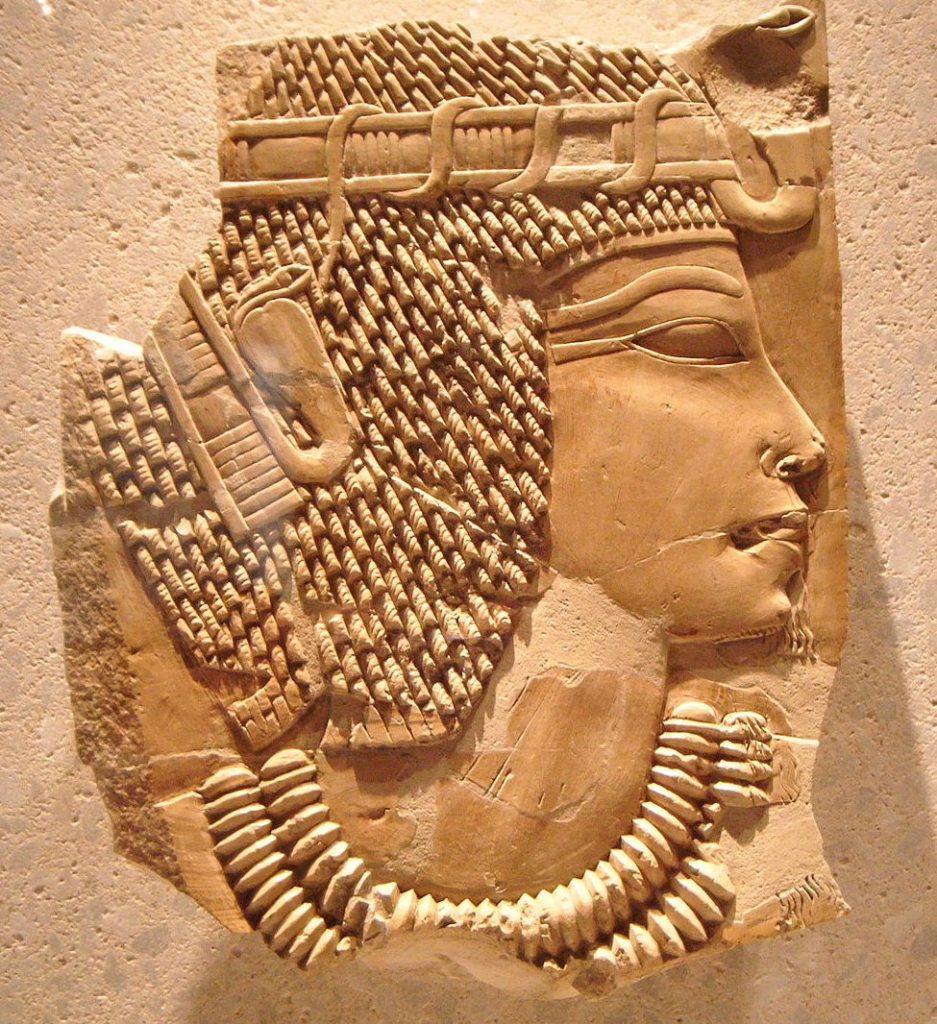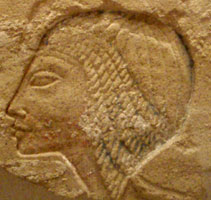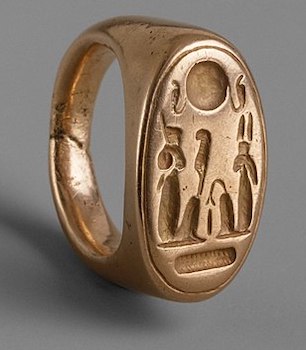Nefertiti is one of the most famous women of the ancient world. She was the chief wife of the “heretic” Pharaoh Akhenaten and may have ruled alongside him. Yet, we do not even know for sure who Nefertiti’s parents were. They may have been of noble or common birth, and may even have been foreign nationals.

It is sometimes suggested that Nefertiti was the daughter of Tiye and Amenhotep III, which would make her a sister or step-sister of Akhenaten. However, she is not referred to as the King’s Daughter, so this is unlikely. She may have been a descendant of Ahmose-Nefertari, who was not actually directly in line to the throne. She did not use the title “God’s wife of Amun”, but this may have been because of its association with the old gods.
Another theory speculates that she was the daughter of Ay, the vizier who later became pharaoh. This is supported by the fact that Ay called himself the “father of the God” (although strictly he would have been the father-in-law of the Pharaoh/God), and Mutbenret (Mutnodjme) who is referred to as Nefertiti’s sister, is mentioned a number of times in Ay’s tomb in the Valley of the Kings. Unfortunately, there are no inscriptions which actually confirm that Ay was her father. Even if he was, it is possible that Nefertiti was a half-sister of Mutnodjme or was adopted by the family (if she was in fact a foreign national).
If Nefertiti was the daughter of Ay, it was probably not by his chief wife, Tey (or Tiy) who was never referred to as “Royal mother of the chief wife of the king”. Instead, Tey is known as the “nurse” or “governess” of the king’s chief wife. It is proposed that Nefertiti’s mother died and Tey acted as a wet nurse or governess for the young girl.

Some comentators have (rather outlandishly) suggested that Nefertiti was in fact the famous Queen Jezebel from the Old Testement. They suggest she left Israel on the death of her husband, King Ahab, and returned when Akhenaten rejected her for failing to provide him with a male heir. Proponents of this view further suggest that Jehu (who caused the death of Jezebel) was in fact the general Horemheb. He became pharaoh after the death of Ay, and destroyed the monuments and inscriptions of the Atenist regime. However, the orthodox chronology would place 500 years between Nefertiti and Jezebel.

Jezebel was an avid defender of the Phonecian Goddess Astarte, which does not tie in too well with Atensim, as Astarte was a war and fertility goddess, while her consort Baal was a rain and storm god. It is tempting to see a similarity between Sekhmet and Astarte (because the later also took the form of a lion from time to time) as a connection between the Phonecian gods and Atensim, but where is the all powerful sun god described by Akhenaten himself? In any case, Jehu was the son of Jehoshaphat who became the tenth King of the northern kingdom of Israel, and the only one of the nineteen kings of Israel to receive glowing praise from Jehovah for his obedience.
Finally, it is suggest that Nefertiti was in fact the Tadukhipa, the daughter of Tushratta (also known as Dasharatha) King of the Mitanni, but most scholars consider it more likely that Tadukhipa was actually Queen Kiya.

Her many names have added to the controversy regarding her background and history. Nefertiti means “the beautiful one approaches” which some have seen as evidence that she was of foreign birth. She may also have been known as “Nefernefruaten” and some suggest that she acted as the co-regent of Akhenaten under this throne name. However, the name is also associated with Smenkhare who is either claimed to be the successor of Akhenaten or Nefertiti herself!
Nefertiti’s Family
“the Mistress of Happiness, Endowed with Favors, at hearing whose voice the King rejoices, the Chief Wife of the King, his beloved, the Lady of the Two Lands, Neferneferuaten-Nefertiti, May she live for Ever and Always”.

It is thought that Akhenaten and Nefertiti has six daughters, Merytaten (born in year 2), Meketaten (born in year 3), Ankhesenpaaten (Ankhesenamun) (born in year 4), Neferneferuaten Tasherit (born in year 6), Neferneferure (born in year 9), and Setepenre (born in year 11). However, it seems that it was Queen Kiya who may have provided Akhenaten with his sons and heirs Smenkhkare and Tutankhamun.
Although Nefertiti was not Akhenaten’s only wife, she was clearly greatly loved by the pharaoh, and seems to have been given a very prominent role in the religious and political life of Egypt. Akhenaten is regularly depicted displaying affection for Nefertiti and her daughters in a unrestrained show of emotion which is pretty much unique to Egyptian art. In one inscription the king described his beloved queen as;
Some theorists suggest that Nefertiti was the author of the religious and cultural revolution initiated by her husband. While this may be an exaggeration, she was clearly important to the new theology as she represented the feminine aspect of the god.

She and her husband were depicted as the archetypal couple who formed a bridge between the Aten and the people. Thus, Nefertiti replaced Isis, Nephthys, Selket (Serqet), and Neith on the four corners of Akhenaten’s sarcophagus and she was regularly shown taking part in the daily worship of the Aten making similar offerings as the king. Furthermore, the queen was depicted smiting enemies, a role generally reserved for the pharaoh alone, and many argue that she acted as co-regent with her husband.
Bibliography
- Dodson, A and Hilton, D. (2004) The Complete Royal Families of Ancient Egypt
- Fletcher, Joann (2013) The Search For Nefertiti
- Van Dijk, Jacobus (2000) “The Amarna Period and later New Kingdom”, in The Oxford History of Ancient Egypt Ed I. Shaw
- Rice, Michael (1999) Who’s Who in Ancient Egypt
- Tyldesley, Joyce (1998) Nefertiti: Egypt’s Sun Queen
- Van De Mieroop, Marc (1999) A History of Ancient Egypt
Copyright J Hill 2010